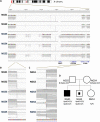Whole-Genome Sequencing of a Family with Hereditary Pulmonary Alveolar Proteinosis Identifies a Rare Structural Variant Involving CSF2RA/CRLF2/IL3RA Gene Disruption
- PMID: 28233860
- PMCID: PMC5324064
- DOI: 10.1038/srep43469
Whole-Genome Sequencing of a Family with Hereditary Pulmonary Alveolar Proteinosis Identifies a Rare Structural Variant Involving CSF2RA/CRLF2/IL3RA Gene Disruption
Abstract
Pulmonary alveolar proteinosis (PAP) is a rare pulmonary disease in which the abnormalities in alveolar surfactant accumulation are caused by impairments of GM-CSF pathway attributing to defects in a variety of genes. However, hereditary PAP is extremely uncommon and a detailed understanding in the genetic inheritance of PAP in a family may provide timely diagnosis, treatment and proper intervention including genetic consultation. Here, we described a comprehensive analysis of genome and gene expression for a family containing one affected child with a diagnosis of PAP and two other healthy siblings. Family-based whole-genome analysis revealed a homozygous deletion that disrupts CSF2RA, CRLF2, and IL3RA gene in the pseudoautosomal region of the X chromosome in the affected child and one of asymptomatic siblings. Further functional pathway analysis of differentially expressed genes in IL-1β-treated peripheral blood mononuclear cells highlighted the insufficiency of immune response in the child with PAP, especially the protection against bacterial infection. Collectively, our results reveal a novel allele as the genetic determinant of a family with PAP and provide insights into variable expressivity and incomplete penetrance of this rare disease, which will be helpful for proper genetic consultation and prompt treatment to avoid mortality and morbidity.
Conflict of interest statement
The authors declare no competing financial interests.
Figures




Similar articles
-
Hereditary pulmonary alveolar proteinosis: pathogenesis, presentation, diagnosis, and therapy.Am J Respir Crit Care Med. 2010 Nov 15;182(10):1292-304. doi: 10.1164/rccm.201002-0271OC. Epub 2010 Jul 9. Am J Respir Crit Care Med. 2010. PMID: 20622029 Free PMC article.
-
Elderly-onset hereditary pulmonary alveolar proteinosis and its cytokine profile.BMC Pulm Med. 2017 Feb 17;17(1):40. doi: 10.1186/s12890-017-0382-x. BMC Pulm Med. 2017. PMID: 28212655 Free PMC article.
-
Gene correction of human induced pluripotent stem cells repairs the cellular phenotype in pulmonary alveolar proteinosis.Am J Respir Crit Care Med. 2014 Jan 15;189(2):167-82. doi: 10.1164/rccm.201306-1012OC. Am J Respir Crit Care Med. 2014. PMID: 24279725
-
Immune dysregulation in the pathogenesis of pulmonary alveolar proteinosis.Curr Allergy Asthma Rep. 2010 Sep;10(5):320-5. doi: 10.1007/s11882-010-0134-y. Curr Allergy Asthma Rep. 2010. PMID: 20623372 Review.
-
Pulmonary alveolar proteinosis, a primary immunodeficiency of impaired GM-CSF stimulation of macrophages.Curr Opin Immunol. 2009 Oct;21(5):514-21. doi: 10.1016/j.coi.2009.09.004. Epub 2009 Sep 30. Curr Opin Immunol. 2009. PMID: 19796925 Free PMC article. Review.
Cited by
-
Uncovering Missing Heritability in Rare Diseases.Genes (Basel). 2019 Apr 4;10(4):275. doi: 10.3390/genes10040275. Genes (Basel). 2019. PMID: 30987386 Free PMC article. Review.
-
Pulmonary alveolarproteinosis in children.Breathe (Sheff). 2020 Jun;16(2):200001. doi: 10.1183/20734735.0001-2020. Breathe (Sheff). 2020. PMID: 32684993 Free PMC article. Review.
-
A murine model of hereditary pulmonary alveolar proteinosis caused by homozygous Csf2ra gene disruption.Am J Physiol Lung Cell Mol Physiol. 2022 Mar 1;322(3):L438-L448. doi: 10.1152/ajplung.00175.2021. Epub 2022 Jan 19. Am J Physiol Lung Cell Mol Physiol. 2022. PMID: 35043685 Free PMC article.
-
Alveolar proteinosis of genetic origins.Eur Respir Rev. 2020 Oct 28;29(158):190187. doi: 10.1183/16000617.0187-2019. Print 2020 Dec 31. Eur Respir Rev. 2020. PMID: 33115790 Free PMC article.
References
-
- Suzuki T. et al.. Hereditary pulmonary alveolar proteinosis caused by recessive CSF2RB mutations. Eur Respir J 37, 201–204 (2011). - PubMed
Publication types
MeSH terms
Substances
LinkOut - more resources
Full Text Sources
Other Literature Sources
Medical
Research Materials

